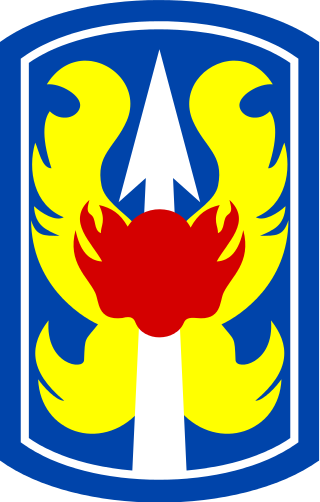Related Research Articles
The 9th Mountain Division was the name given to two separate German military divisions by accident in 1945.

The 199th Infantry Brigade (Light) is a unit of the United States Army which served in the Army Reserve from 1921 to 1940, in the active army from 1966 to 1970 (serving in the Vietnam War), briefly in 1991–1992 at Fort Lewis, and from 2007 as an active army training formation at Fort Moore.

The 256th Infantry Brigade Combat Team is a modular infantry brigade combat team (IBCT) of the Louisiana Army National Guard. It is headquartered in Lafayette, Louisiana. Currently the brigade is part of the 28th Infantry Division of the Pennsylvania Army National Guard.

The Georgia Army National Guard is the Army National Guard component of the Georgia National Guard, administratively part of the Georgia Department of Defense. It consists of more than 11,100 citizen-soldiers training in more than 79 hometown armories and regional facilities across the state. Georgia’s Army Guard is the sixth largest in the nation and includes combat, combat support and combat service support units.
The 67th Guards Rifle Division was formed as an elite infantry division of the Red Army in January, 1943, based on the 1st formation of the 304th Rifle Division, and served in that role until after the end of the Great Patriotic War. It was officially redesignated in the 65th Army of Don Front, in recognition of that division's leading role in reducing the German 6th Army during Operation Ring, the destruction of the encircled German and Romanian forces at Stalingrad. During the following months it was substantially rebuilt while moving north during the spring of the year. The division put up a very strong defense in the Battle of Kursk, facing some of the main elements of Army Group South, and then attacked through the western Ukraine after the German defeat. Along with the rest of 6th Guards Army it moved further north to join 2nd Baltic and later 1st Baltic Front in the buildup to the summer offensive against Army Group Center, winning a battle honor and shortly after the Order of the Red Banner in the process. During the rest of 1944 it advanced through the Baltic states and ended the war near the Baltic Sea, helping to besiege Army Group Courland in 1945. The 67th Guards was disbanded in 1946.

The 197th Infantry Division was a Wehrmacht division in World War II. It was activated on 1 December 1939.

The Tennessee Army National Guard is a component of the United States Army and the United States National Guard. It is administered by the Tennessee Military Department. National coordination of various state National Guard units are maintained through the National Guard Bureau.
In the German Wehrmacht before and during World War II, infantry divisions were raised as part of a designated Aufstellungswelle or Welle (wave), sometimes translated as "draft". The Aufstellungswelle system was adopted by the Wehrmacht in late 1938. Peacetime units were the first wave, and 34 other waves followed until the 35th wave in April 1945. Several types of divisions were organized by Aufstellungswelle, including infantry, security, shadow and Volksgrenadier divisions.
The 162nd Infantry Division(162. Infanterie-Division) was an infantry division of the Heer of Nazi Germany's Wehrmacht during World War II.
The 166th Infantry Division was an infantry division of the German Heer during World War II. The unit, at times designated Commander of Reserve Troops 2 of Wehrkreis VI
The 180th Infantry Division was an infantry division of the German Heer during World War II. The unit, at times designated Commander of Reserve Troops X/II, 180th Division, Division No. 180, and Operation Division No. 180, was active between 1939 and 1945.
The 196th Infantry Division was an infantry division of the German Heer during World War II.
The 251st Infantry Division was an infantry division of the German Heer during World War II.
The 260th Infantry Division was an infantry division of the German Heer during World War II.
The 265th Infantry Division was an infantry division of the German Heer during World War II.
The 270th Infantry Division was an infantry division of the German Heer during World War II.
The 274th Infantry Division was an infantry division of the German Heer during World War II.

The 306th Infantry Division was an infantry division of the German Wehrmacht during World War II.
The 73rd Guards Rifle Division was reformed as an elite infantry division of the Red Army in March 1943, based on the 2nd formation of the 38th Rifle Division, and served in that role until after the end of the Great Patriotic War.
The 416th Infantry Division was a German infantry division of World War II.
References
- 1 2 3 4 5 6 7 8 Tessin, Georg (1972). "199". Die Landstreitkräfte 131-200. Verbände und Truppen der deutschen Wehrmacht und Waffen-SS im Zweiten Weltkrieg 1939-1945 (in German). Vol. 7. Osnabrück: Biblio Verlag. pp. 289–292. ISBN 3764808721.
- 1 2 3 4 5 6 Mitcham, Samuel W. (2007). "199th Infantry Division". German Order of Battle. Volume One. 1st-290th Infantry Divisions in World War II. Stackpole Books. pp. 249–250. ISBN 9780811734165.